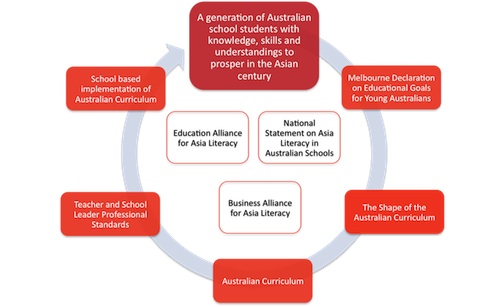Why Asia literacy?
This section invites teachers to examine the need for Asia literacy in an increasingly globalised world. The Asia priority in the Australian Curriculum is examined as is its history in the policy statements of Australian education. Suggestions are included for examining the policy in terms of the moral imperative for teaching the Asia priority through English and History.
Task 1: The Asia priority in the Australian Curriculum
AEF's definition of Asia literacy is:
…foundational and deep knowledge, skills and understandings about the histories, geographies, societies, cultures, literature and languages of the diverse countries that make up our region.
The Asia and Australia's engagement with Asia cross-curriculum priority provides the opportunity for teachers and students to celebrate the social, cultural, political and economic links that connect Australia with Asia.
The aim of the Asia priority is to ensure that:
…students learn about and recognise the diversity within and between the countries of the Asia region. They will develop knowledge and understandings of Asia societies, cultures, beliefs and environments, and the connections between the peoples of Asia, Australia and the rest of the world. Asia literacy provides students with the skills to communicate and engage with the peoples of Asia so they can effectively live, work and learn in the region. (ACARA, 2013)
- A student starting school in 2013 will exit in 2031. Brainstorm the skills, knowledge and competencies that students may require to participate in and contribute to our region of the world 20 years from now.
- How can English and History provide opportunities for students to participate in and contribute to our region of the world 20 years from now?
Task 2: Twelve case studies on developing Asia literacy
In the full Asia literacy and the Australian teaching workforce research report there are 12 case studies from primary and secondary teachers across Australia. They are cross-referenced to the Australian national professional standards for teachers.
Task 3: Asia literacy in the Australian national education landscape
In Australia there are three key national policy platforms that authorise the Asia priority in the Australian Curriculum:
- Melbourne declaration on educational goals for young Australians
- AEF National Statement (PDF 299 KB)
- Australian Curriculum
The diagram below demonstrates how the policy documents link to the outcome of Asia-capable Australian students.

- How might you share the key messages from the policy documents with your faculty?
- How might these policy documents support you in developing a case for leading Asia literacy in English and History?
Task 4: Do all teachers need to teach the Asia priority?
Yes. The Australian Curriculum identifies Asia and Australia's engagement with Asia as a priority across the curriculum and at all levels of schooling from Foundation to Year 10.
Asia literacy is therefore a curriculum imperative and policy enacted through the Australian Curriculum. As such all teachers, whether primary or secondary, regardless of sector and regardless of key learning area are teachers of Asia literacy.
- Read the Australian Curriculum, Assessment and Reporting Authority (ACARA) statement on Asia and Australia's engagement with Asia as a priority across the curriculum and consider what skills are needed by teachers and students to 'communicate and engage with the peoples of Asia so they can effectively live, work and learn in the region'.
- What subject-specific skills can be taught in English and History to ensure students can 'effectively live, work and learn in the region'?
Task 5: The moral imperative for teaching about Asia
Michael Fullan, Professor Emeritus at the Ontario Institute for Studies in Education at the University of Toronto, argues that the moral imperative is the critical component of any change process. He argues that to effect change, you must first address the moral purpose and identifies 'engaging people's moral purposes' as the foremost force in creating effective and lasting change.
The first overriding principle is knowledge about the why of change, namely moral purpose. In education, moral purpose involves committing to raise the bar and close the gap in student achievement … Moral purpose is not just a goal but a process of engaging educators, community leaders, and society as a whole in the moral purpose of reform. If moral purpose is front and centre, other drivers become additional forces for enacting moral purpose.
Change: making it happen in your school and system (PDF 5 MB) by Michael Fullan
Fullan argues that the most effective way to support people to change is to tackle their intrinsic motivations and to do this in a direct manner. He notes that the effective leader activates, enables and mobilises human and moral purpose and the skills to enact them.
- What are the moral imperatives for teaching about Asia in English and History in your faculty and school?
- What most convinces you of the need for including Asia content in English and History in your school context?
- Consider what other imperatives there are for teaching about Asia including, for example, cultural exchange, intercultural understanding, future work choices, learning and studying in the region, and changing global economic patterns.
- Consider how the general capabilities development of 21st century skills can be strengthened through the moral imperative of teaching about Asia.